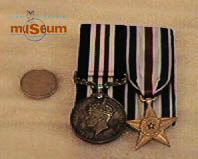These two Military Medals for Valor were awarded during the Second World War. One of the medals is silver in color with an embossed side portrait of King George VI (uncrowned). The outer edge of medal reads, “GEORGIVS VID. G:BR:OMN REX ET INDIAE IMP:”. Reverse reads, “FOR BRAVERY IN THE FIELD”, encircled by a laurel wreath and surmounted by the Royal Cypher and Crown. Rim reads, “H 41406 SGT.A. T. RICHARDSON C.INF.C.” Medal is attached to a navy, red and white striped ribbon by an ornate scroll suspender with single toe claw and inward scroll claws. The ribbon is folded around a piece of cardboard covered with navy fabric.
Sergeant Alfred F. Richardson of the Royal Winnipeg Rifles was awarded the Military Medal and later the Silver Star Medal by the United States War Department. The actions for which he received these honors took place in October, 1944 and on April 7, 1945 in North West Europe during W.W.II. Richardson would also have been awarded a standard set of WWII medals in addition to added bars and pins for having served overseas.
The Military Medal is awarded to Warrant Officers, NCOs and men for individual or associated acts of bravery and devotion under fire on the recommendation of a Commander-in-Chief in the Field. Only 12,345 Military Medals were issued with George V, and only 1360 of those to Canadians, so it is a rare and valuable item.
“On February 11, 1945, Canadian forces attacked German positions at the Dutch village of Keeken, 7 miles east of Nijmegen. During the battle, the left flank of the Western Canadian Battalion was shredded, losing all of its officers. Platoon Sergeant Al Richardson of the Royal Winnipeg Rifles leapt into the breach and rallied the surviving troops. The battle in the ‘take-no-prisoners’ offensive was up close and personal, culminating in grenade duels from ten yards away. Richardson, a D-Day veteran, was well familiar with German tactics. He later explained that, when the Nazis realized they are about to lose a battle, they open fire with their artillery whether their soldiers are there or not. As a result, the scene was “quite wicked,” as shells showered death upon both Allies and Germans. The Canadian troops persisted and eventually captured the German position.”


